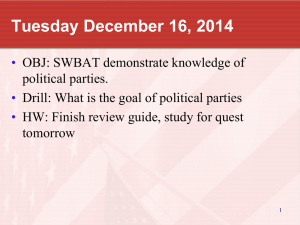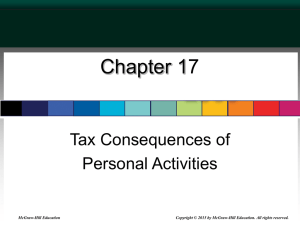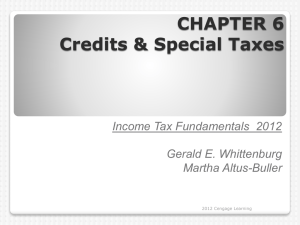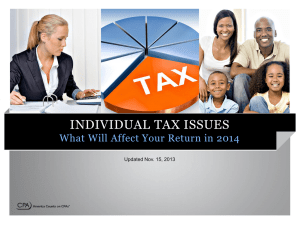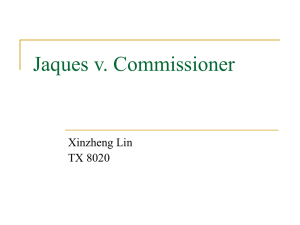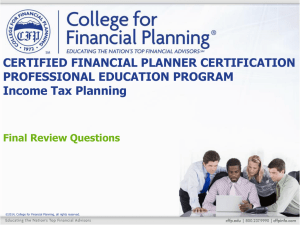CHAPTER 1
advertisement
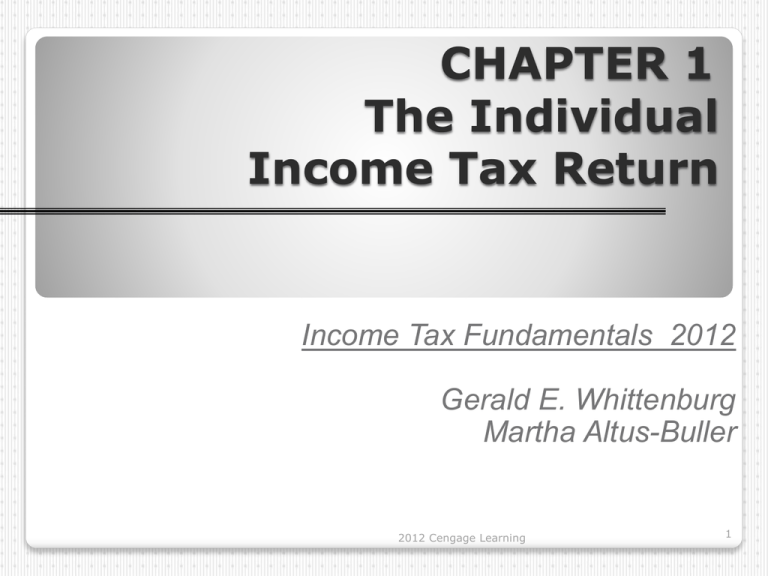
CHAPTER 1 The Individual Income Tax Return Income Tax Fundamentals 2012 Gerald E. Whittenburg Martha Altus-Buller 2012 Cengage Learning 1 Learning Objectives Understand history/objectives of U.S. tax law Describe different entities subject to tax/reporting requirements Understand and apply tax formula Identify who must file tax returns Determine filing status & understand calculation of tax according to filing status Calculate number of exemptions and exemption amounts Calculate correct standard or itemized deduction amount for taxpayers Compute basic capital gains and losses Access and use various internet tax resources Understand the basics of e-filing 2012 Cengage Learning 2 History of Taxation 1913, when 16th amendment was passed, the constitutionality of income tax has never been questioned Since Income taxes serve a multitude of purposes 2012 Cengage Learning 3 Objectives of Tax Law Raise revenue Tool for social and economic policies ◦ Social policy encourages desirable activities and discourages undesirable activities Credits for investment in solar and wind energy Can deduct charitable contributions Credits for higher education expenses ◦ Economic policy as manifested by fiscal policy Encourage investment in capital assets through depreciation ◦ Both economic and social Exclude gain on sale of personal residence up to $250,000 ($500,000 if married) 2012 Cengage Learning 4 Primary Entities/Forms Individual ◦ Taxable income includes wages, salary, selfemployment earnings, rent, interest and dividends ◦ An individual may file simplest tax form qualified for 1040EZ 1040A See next slide 1040 ◦ If error made on one of the three above forms, can amend with a 1040X 2012 Cengage Learning 5 Primary Entities/Forms Individual ◦ 1040EZ Single or Married Filing Jointly (MFJ) Must not be 65 or older and/or blind Must not claim any dependents Taxable income must be under $100,000 Only wages, salaries or unemployment and not more than $1,500 taxable interest income Not claim any credits other than the earned income credit 2012 Cengage Learning 6 Primary Entities/Forms Individual (continued) ◦ 1040A Generally used by taxpayers who are not selfemployed and don’t itemize deductions ◦ 1040 If taxpayer doesn’t qualify to use 1040EZ or 1040A,should complete a 1040 with possible schedules attached ◦ Schedule A to itemize deductions ◦ Schedule B to report dividends/interest income > $1500 ◦ Schedule C to report trade/business income ◦ Schedule D to report capital gains/losses ◦ Schedule E to report rental/royalty income ◦ Schedule F to report farm/ranch activities 2012 Cengage Learning 7 Primary Entities/Forms Corporations ◦ Tax rate schedule found on page 1-4 ◦ Corporations need to file 1120 or 1120S ◦ 1120S is for corporations that elect S Corporation status Don’t pay regular corporate income taxes Instead, pass through items of income or loss to shareholders Partnerships ◦ Reporting entity, not taxable entity ◦ 1065 – reports income/loss and allocation to partners Pass through items of income or loss to partners 2012 Cengage Learning 8 Tax Formula for Individuals This formula follows Form 1040 Gross Income less: Deductions for Adjusted Gross Income (AGI) AGI less: Greater of Itemized or Standard Deduction less: Exemption(s) Taxable Income times: Tax Rate (using tax tables or rate schedules) Gross Tax Liability less: Tax Credits and Prepayments Tax Due or Refund 2012 Cengage Learning 9 Standard Deduction & Exemptions 2011 standard deduction ($) Single Married Filing Joint (MFJ) Qualifying Widow(er) 5,800 11,600 11,600 also known as Surviving Spouse (SS) Head of Household (HOH) Married Filing Separate (MFS) 8,500 5,800 *Taxpayers 65 or older and/or blind get an additional amount $1,150 if MFJ, MFS or SS $1,450 if HOH or Single 2011 exemption $3,700 – personal & dependency 2012 Cengage Learning 10 Using Tax Formula Facts: Juan (age 29) is a single taxpayer. In 2011, his salary is $39,000 and he has dividend income of $1000. In addition, he has deductions for AGI of $2,500 and $3,000 of itemized deductions. If Juan claims one exemption for this year, calculate the following amounts: Gross income ___________ Deductions for AGI ___________ Adjusted gross income ___________ Greater of the standard deduction or itemized deductions Exemptions ___________ ___________ Taxable income ___________ 2011 Cengage Learning 11 Solution Gross income $40,000 Adjusted gross income ___________ Greater of the standard deduction or itemized deductions ___________ Exemptions ___________ Taxable income ___________ Gross income = $39,000 + 1,000 2012 Cengage Learning 12 Solution Gross income Adjusted gross income $40,000 37,500 Greater of the standard deduction or itemized deductions ___________ Exemptions ___________ Taxable income ___________ AGI = $40,000 – 2,500 2012 Cengage Learning 13 Solution Gross income Adjusted gross income Greater of the standard deduction or itemized deductions $40,000 37,500 5,800 Exemptions Taxable income ___________ The standard deduction of $5,800 exceeds itemized deductions of $3,000 2012 Cengage Learning 14 Solution Gross income Adjusted gross income $40,000 37,500 Greater of the standard deduction or itemized deductions 5,800 Exemptions 3,700 Taxable income $28,000 2012 Cengage Learning 15 Who Must File Based on filing status and gross income ◦ Generally, if exemptions plus greater of standard or itemized deductions exceed income, then filing is not necessary ◦ If taxpayer is claimed as a dependent on another taxpayer’s return, dependent’s standard deduction is: Greater of $950 See Figures 1.1 or and 1.2 on page 1-8 Earned income + $300 But never more than standard deduction 2012 Cengage Learning 16 Who Must File Taxpayer must file if ◦ Owe any special taxes See Figure 1.3 on page 1-9 ◦ Had self-employment income >= $400 ◦ Other special situations as outlined on Chart C (Figure 1.3) 2012 Cengage Learning 17 Which Taxpayers are Required to File Note: Must analyze each independent situation to determine if the taxpayer is required to file a return for 2011 Miles (age 45) is a single waiter and has unreported tips of $1,510; is he required to file? Yes, because Miles owes social security taxes on unreported tips. 2012 Cengage Learning 18 Which Taxpayers are Required to File Simone is single (age 31) and blind and has income of $10,370; is she required to file? No, because standard deduction = $7,250 ($5,800 + 1,450); exemption= $3,700. These amounts total to $10,950 and exceed her gross income. 2012 Cengage Learning 19 Which Taxpayers are Required to File Eamon (age 67) and his wife, Roisin, (age 69) have income of $19,180 and file jointly; are they required to file? No, because standard deduction = $13,900 ($11,600 + 1,150 + 1,150); exemptions = $7,400. These amounts total to $21,300 and exceed their gross income. 2011 Cengage Learning 20 Which Taxpayers are Required to File Taig is a single full time college student, age 21, with wages from a part-time job of $7,340. He is claimed as a dependent by his parents; is he required to file? Yes, because Tai’s standard deduction = $5,800 and his income exceeds this amount. His exemption is 0 as he’s claimed by parents. 2012 Cengage Learning 21 Filing Status Single ◦ Unmarried or legally separated as of 12/31 ◦ And not qualified as married filing separately, head of household or qualifying widow(er) Married Filing Jointly (MFJ) ◦ If married on 12/31 – even if didn’t live together entire year ◦ Same-sex couples may not file jointly ◦ If spouse dies during year you can file MFJ in current year Married Filing Separately (MFS) ◦ Each file separate returns ◦ Must compute taxes the same way - both itemize or both use standard ◦ If living in community property state, must follow state law 2012 Cengage Learning 22 Filing Status Head of Household (HOH) ◦ Tables have lower rates than single or MFS ◦ Taxpayer can file as HOH if: Unmarried or abandoned* as of 12/31 Paid > 50% of cost of keeping up home that was principal residence of dependent child or other qualifying dependent relative There is one exception to principal residence requirement. If dependent is taxpayer’s parent, he/she doesn’t have to live with taxpayer. Note: A divorced parent who meets above rules and has signed IRS/legal document, may still claim HOH even if dependency exemption shifted to ex-spouse *See pages 1-10 and 1-11 for requirement for abandoned spouse 2012 Cengage Learning 23 Filing Status Qualifying Widow(er) with Dependent Child ◦ Also known as surviving spouse ◦ Available for two subsequent years after death of spouse Must pay over half the cost of maintaining a household where a dependent child, stepchild, adopted child or foster child lives ◦ Gets benefits of married filing joint tax rates 2012 Cengage Learning 24 Tax Computation Six brackets (in Appendix) ◦ 10%, 15%, 25%, 28%, 33%, 35% ◦ Tax rate schedules for different filing types Qualifying dividends and net long-term capital gains may be taxed at lower rates ◦ Rates based on ordinary tax bracket 2012 Cengage Learning 25 Personal/Dependency Exemptions Personal exemptions may be taken for self and spouse Additional exemptions may be taken for individuals who are either taxpayer’s ◦ Qualifying child or ◦ Qualifying relative For 2011 each exemption = $3,700 2012 Cengage Learning 26 Dependency – Qualifying Child Dependency exemption allowed when six tests met Relationship Test - child is taxpayer’s child, stepchild, adopted child or taxpayer’s sibling, half- or step-sibling, or a descendant of any of these. Foster child may also qualify. Child must be younger than person claiming him/her, unless permanently disabled. Domicile Test- child has same principal place of abode as taxpayer for more than ½ the year. Age Test – child is under 19 or a full-time student under 24 (enrolled at least 5 months of year). 2012 Cengage Learning 27 Dependency – Qualifying Child Joint Return Test – child doesn’t file joint return with spouse (exception: if it’s only to claim refund, then considered to have passed this test). Citizenship Test – child is a US citizen, a resident of the US, Canada or Mexico, or an alien child adopted by and living with a US citizen. Self-Support Test – child who provides more than ½ of his/her own support cannot be claimed as a dependent of someone else. Funds received by students as scholarships are excluded from support test. 2012 Cengage Learning 28 What if Child Meets Dependency Requirements for More than One Taxpayer? If one of the parties is a parent, he/she can claim If both parties are a parent, then one with whom the child resides longest can claim o If not ascertainable, parent with highest AGI may claim If no parents are involved, person with highest AGI may claim Note: If parents are legally separated/divorced, person with whom child resides more than 6 months may claim. Exemption can shift if custodial parent signs Form 8332 and form is attached to noncustodial parent’s tax return 2012 Cengage Learning 29 Dependency – Qualifying Relative Dependency exemption may be granted for a qualifying relative (who is not a qualifying child) based on tests on next slide. Note: A taxpayer’s child who does not meet qualifying child test may meet qualifying relative test!! 2012 Cengage Learning 30 Dependency – Qualifying Relative Relationship or Member of Household Test – list of relatives that qualify is available at IRS web site Note: A member of household (even if unrelated) for entire year meets the relationship test Gross Income Test – individual may not have gross income in excess of $3,700 Support Test – dependent must receive over ½ of his/her support from taxpayer Joint Return Test – dependent may not file a joint return unless it’s solely to claim refund Citizenship Test – dependent must meet the citizenship test identified in the qualifying child slide 2012 Cengage Learning 31 Standard Deduction 2011 standard deduction Single Married Filing Joint (MFJ) Qualifying Widow(er) $ 5,800 $11,600 $11,600 also known as Surviving Spouse Head of Household (HOH) Married Filing Separate (MFS) $ 8,500 $ 5,800 *Plus additional amounts for blindness or over 65: $1,150 if MFJ, MFS or qualifying widow(er) and $1,450 if HOH or Single 2012 Cengage Learning 32 Standard Deduction - Dependents The special rule for standard deduction for dependents is “Deduction = Greater of $950 or earned income + $300, but only up to basic standard deduction” Example 1: Jaime is 23 and a full time student and her parents claim her as a dependent; she earned $2,000 in 2011, how much is taxable income? $2,000 earned income (2,000) standard deduction $0 taxable income Example 2: Tia is 18 - has dividend income of $1,500 (dividends are considered unearned income), how much is taxable income? $1,500 dividend income ( 950) standard deduction $ 550 taxable income 2012 Cengage Learning 33 Basic Gain & Loss Model Amount Realized* - Adjusted Basis** Realized Gain/Loss * Sales Price - Sales Expenses ** Cost - Accumulated Depreciation Note: Most realized gains/losses are also recognized (i.e. – included in taxpayer’s income) 2012 Cengage Learning 34 Capital Gains/Losses A capital asset is any property (personal or investment) held by a taxpayer, with certain exceptions as listed in the tax law ◦ Examples: stocks, bonds, land, cars and other items held for investment ◦ Gains/losses on these assets are subject to special rates Holding period of asset determines treatment ◦ Long-term is held >12 months (taxed at capital rates – see next screen) ◦ Short-term is held <= 12 months (taxed at ordinary rates) 2012 Cengage Learning 35 Capital Gains/Losses Long term capital gain ◦ Special rates depending upon taxpayer’s bracket Ordinary Tax Bracket Capital Gains Tax Rate 10% or 15% All other brackets Long 0% 15% term capital loss ◦ Only allowed $3,000 net capital loss per year against ordinary income ◦ Carry-forward any unused balance 2012 Cengage Learning 36 Calculating Gain/Loss Facts: Noah purchased Sony AAA bonds in 2006 for $47,600. In 2011, he sold the bonds for $51,500, paying commission of $515. What is his: Amount realized ___________ Adjusted basis ___________ Realized gain/loss ___________ Recognized gain/loss ___________ Type of gain/loss ___________ 2012 Cengage Learning 37 Solution Amount realized * Adjusted basis $50,985 47,600 Realized gain/loss 3,385 Recognized gain/loss 3,385 Type of gain/loss Long term capital gain *Amount realized = $51,500 – 515 2012 Cengage Learning 38 Tax and The Internet Volumes of tax information available on internet o http://www.irs.gov contains forms and publications and a search engine to aid the user in obtaining useful information The IRS has also launched a YouTube video site and an iTunes podcast site featuring topics like how to obtain refund or file an extension Other good sites include www.hrblock.com and www.willyancey.com In some states, names of delinquent taxpayers posted on web sites 2012 Cengage Learning 39 Electronic Filing Rules in constant transition, as IRS attempts to transition all taxpayers to e-filing Taxpayers may prepare electronic returns using own PC and tax preparation software or May utilize a paid preparer who employs e-filing 2012 Cengage Learning 40 The End! 2012 Cengage Learning 41




